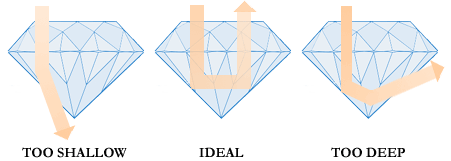| Diamonds | |
| Diamond Cut | |
|
Of the four Cs which determine quality, diamond cut is the most complex to understand and likely the most important characteristic in choosing a diamond. The jewelry industry uses the word "cut" in two different ways. First, it's used to describe the shape of a stone (for example, an "emerald cut" diamond). Second, it is used to describe the reflective qualities of a stone. The reflective quality is determined by how well the stone was cut during the process of transforming the rough stone into a beautiful jewel. This second usage (the reflective qualities) is the one that is graded and gets a score. The quality of the cut makes an enormous difference in how a diamond looks. The symmetry of the stone’s facets and its overall proportions determine the stone's ability to reflect light. A good cut gives a jewel its brilliance, a brightness that comes from the very heart of the stone. An expertly cut diamond will achieve high levels of brilliance, sparkle, and durability. Conversely, even if a diamond or gemstone is graded well in other areas, a poor cut can result in a dull, muted effect. When a diamond is fashioned from a rough stone, the cutter must balance optimal cut (and therefore appearance) against maximum yield (cutting the diamond to maintain as much carat weight from the rough stone as possible). Because many customers are willing to pay more for a larger, fair-cut diamond than for a slightly smaller, well-cut diamond, there is pressure on the cutter to sacrifice appearance for weight. This is why the Cut grade is so important; it allows the purchaser to identify those stones that were cut Fair to Poor in an effort to gain carat weight.
|
|
| Diamond Terminology | |

| Crown | The top part of the diamond from the girdle to the table. |
| Crown Angle | The angle of the crown with respect to the girdle. |
| Culet | The tiny facet on the bottom tip of the diamond. |
| Depth | The diamond measurement from the table to the culet. |
| Diameter | The width of the diamond from one side of the girdle to the other. |
| Girdle | The edge of the diamond between the crown and the pavilion. The girdle is the part of the diamond with the largest circumference. |
| Pavilion | The part of the diamond from underneath the girdle to the culet. |
| Pavilion Angle | The angle of the pavilion with respect to the girdle. |
| Table | The largest facet of the diamond, which comprises the flat surface on the top of the stone, resembling a table. |
|
In the diagram below, three common light patterns are shown. When light meets any facet of a diamond, it will either reflect (bounce back) or refract (bend while passing through the facet). The angle that the light hits the facet determines whether the majority of light reflects or refracts, which is why the stone cut is so important. |
|
 |
|
| Questions? We'll be glad to help. We will answer any questions you have, and if you like, search for diamonds on your behalf that match your criteria. Email us at info@assortedgemscorp.com or call 1-212-719-1535. |
